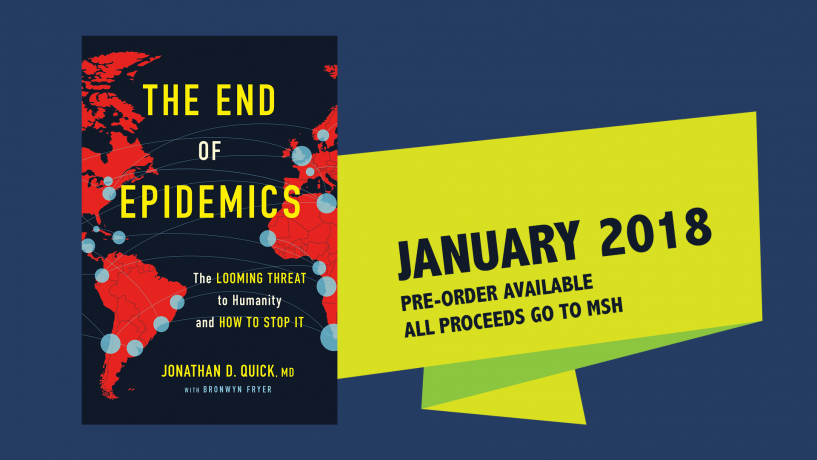Why I Wrote The End of Epidemics
Why I Wrote The End of Epidemics
By Jonathan Quick

The Ebola epidemic was raging in West Africa. Management Sciences for Health’s staff in Liberia relayed that “treatment facilities are overrun with cases” and “whole parts of the health system are at a standstill.” Things got much worse before the epidemic was finally defeated. Over 11,000 people died horribly from the disease, leaving more than 16,000 children orphaned.
Once the world woke up to the crisis, there was a generous outpouring of assistance. As the response peaked, I was consumed by nagging questions: Where will we be four or five years from now? Will the world have gone back to sleep? What’s needed to protect the world from future outbreaks? To find the answers, I explored the lessons from epidemics over the last century – smallpox, AIDS, SARS, avian flu, swine flu, Ebola, Zika – and I drew on some of the best minds, experienced professionals and committed citizen activists in global health, infectious disease, and pandemic preparedness.
The conclusions were both extremely unsettling and highly encouraging. Unsettling because a replay of the 1918 Spanish flu – against which we are not yet prepared – could hit every major city in the world within 200 days, claim more than 300 million lives, ravage national economies with the force of the Great Recession, and close public services and business around the globe. Weak epidemic preparedness is less about gaps in public health know-how than it is about public complacency, political inaction, and collective underinvestment. As a result, we allow the threat to grow – accelerated by urbanization, international travel, global warming, food demand, population growth and armed conflict.
What drove me to write The End of Epidemics: The Looming Threat to Humanity and How to Stop It, however, were the compelling stories of public health heroes and the convincing evidence of success that demonstrated public health leaders have the potential to keep local outbreaks from exploding into devastating epidemics. This requires strong leadership and additional annual investments of $7.5 billion – just $1 for each global inhabitant – from public, private, and philanthropic sources over the next two decades.
Unfortunately, as we have seen time and again, when an outbreak is far from home and the headlines fade, political and public interest wanes – and with it the commitment and resources to prevent future epidemics. Therefore, I’ve written The End of Epidemics to engage policymakers, business leaders, youth, and the general public. I talk not just about the threats from the barn (bird flu, swine flu), the bush (AIDS, Ebola, Zika), and bioterrorists, but more importantly about the Power of Seven – concrete, achievable solutions that together will save millions of lives. These include courageous leadership, resilient health systems, active prevention, trusted communications, game-changing innovation, targeted annual investment, and citizen activism.
Mercifully, in the three years since the Ebola peak, the world has not gone back to sleep. To the contrary, the battle against pandemic threats has attracted many high-profile champions, including heads of state, Bill Gates, WHO Director General Dr. Tedros, Médecins Sans Frontières President Dr. Joanne Liu, Unilever CEO Paul Polman, and many others whom you will read about in The End of Epidemics. The Global Health Security Agenda (GHSA), launch in 2014, is ambitiously working to strengthen national and global capacity to combat infectious diseases threats through its growing partnership of more than 50 nations, international organizations, NGOs, businesses etc. The GHSA has in turn created new civil society, private sector, public-private, multi-stakeholder, young professionals, and related collaborations.
The challenge now is sustaining this momentum. This is where the raised voices of public health advocates and citizen activists come in. A mobilized global citizenry can elevate epidemic prevention on the agendas of national and world leaders and hold them accountable for progress toward their commitments.
It is my earnest hope that The End of Epidemics will help catalyze and inform such a movement. Explore how you can take action at www.endofepidemics.com. Together we can create a powerful global force. As a family doctor, I have felt the profound human pain when a family loses a beloved child, parent, or sibling. And I have been inspired by the success of collective action against scourges like AIDS and preventable maternal and child mortality.
I’m encouraged by pre-publication praise forThe End of Epidemics from Kirkus Review and Publishers Weekly as well as endorsements from distinguished experts, including Dr. Paul Farmer, Dr. Joanne Liu, Prof. Peter Piot, and Dr. Heidi Larson. The End of Epidemics, available for preorder, will be released January 30, 2018 in the U.S. and March 2018 in the UK and Australia. Proceeds go to strengthening Management Sciences for Health’s technical contributions to strengthening health systems for global health security.
There will always be new infectious disease outbreaks. But by working intensely together in the coming years, we can leave our children a world safer from new epidemics and pandemics that kill thousands or millions. We know what is required. But we must maintain the momentum, make the essential investments, and have the persistence. There is no excuse for unpreparedness. The threat is real. The pathway is known. The time for action is now.
Explore how you can take action at www.endofepidemics.com.